Rehabilitation is a powerful word these days. Fashionable, too. In wildlife conservation, rehabilitation can serve functions ranging from augmenting threatened animal populations to desperate attempts to save species from permanent extinction.
At its base, rehabilitation consists of handling, preparing and releasing wild animals that have been in some way negatively affected by humans. Rehabilitation programs cover the globe (from cottage-scale sparrow and raccoon rescues in suburban parks to well-established raptor protection programs, wolf rehabilitation and public education about these wild predators in Colorado, semi-touristy rehabilitation centers in Thailand housing everything from gibbons to elephants, vet hospitals dedicated to flu-ridden bobtail lizards in Australia, and sexy lion and cheetah hubs in southern Africa which breed endangered serval cats). The motivations behind these programs are also diverse, but the umbrella goal is unified: to aid the continued survival, so often precarious, of animals valued by people.
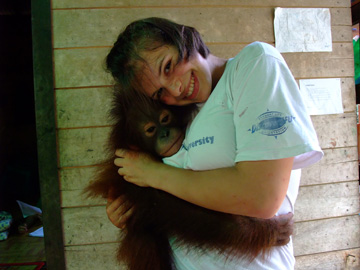 Author with ex-captive orphan Ariel in the rehabilitation program. Photo courtesy of Janie Dubman. |
Right now, rehabilitation is a particularly red-hot issue within orangutan conservation. The Asian great apes, localized to the islands of Borneo and Sumatra, are lumbering, in their awkward but graceful arboreal way, ever closer to the extinction precipice. As biologists and conservationists are all too aware, extinction risk is defined not only by how few individual animals or populations remain, but also by how rapidly they are vanishing. Orangutans are disappearing off this planet at the same rapid rate as the jungles that are their home. In the midst of this conservation drama, a considerable number of passionate individuals and organizations are fighting a battle to preserve these endearing red apes. The techniques and strategies which they employ range from radical to ridiculous, creative to compassionate, traditional to innovative—complex problems require complex solutions. It seems like all angles are being worked: land purchasing and reserve establishment, ecotourism and community development, campaigning and rehabilitation—each approach has its advocates and critics. It’s exciting and maddening.
Rehabilitation, however, is undoubtedly one of the heavyweight players, both in terms of global and local attention, and in terms of controversy. The rehabilitation process is not rocket science: animals are confiscated or surrendered to a center, fed, taught and nurtured by experienced handlers, and then taken returned to the wild, with some preparation and varying degrees of follow up care. There are several currently active and well-known orangutan rehabilitation centers (for a few, see: http://www.yorku.ca/arusson/rehab_sites.htm).
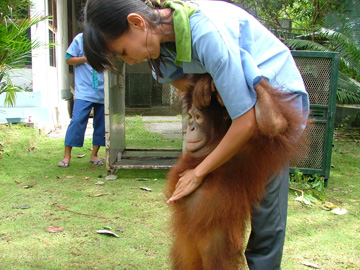 Saut undergoing last checks by head vet. Photo courtesy of Janie Dubman. |
This is where I want to take you. For people who are highly knowledgeable on these topics, I hope this case study is useful and interesting; for the curious explorer, sit back and enjoy the adventure.
Orangutan Foundation International has been doing rehabilitation since before it became trendy—1971. Spearheaded by Dr. Birute Mary Galdikas, the project was conceived in the heart of Tanjung Puting National Park in the south of Kalimantan Tengah (Central Indonesian Borneo); when it grew too big to be run alongside the long-term wild orangutan studies in the park, it was relocated to a new and specialized facility in nearby village Pasir Panjang in 1997.
Fast-forward to summer 2009, when I came to KalTeng (as the province is locally abbreviated), and lost my head and heart to the place and its inhabitants (of human and non-human animals). I got involved in OFI’s work, both on the ground and indirectly in Canada, and then gravitated back to the equator in the summer of 2010.
Most of OFI’s final jungle releases occur in the summer months for various reasons, and this year was no exception. I was part of one of these releases, having experience and understanding of the confiscation, nurturing and training phases of the rehabilitation process. Needless to say, a successful re-introduction into the wild is a deeply satisfying event for everyone involved.
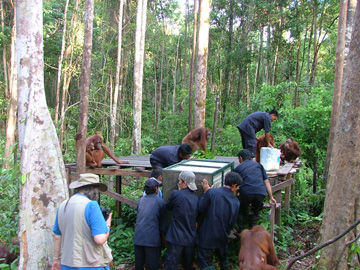 The moment of release. Photo courtesy of Janie Dubman. |
Preparation for release consists of stringent medical and observational tests. Animal patients are screened for medical conditions and illnesses which they may transfer to encountered wild peers, and which may significantly impair their own chance of survival in the forest. Before these tests are even run, young orangutans are monitored for months for behaviors which indicate their physical and psychological readiness for release—some of the basic ones are proficient climbing, consistent nest-building and emotional independence from their foster carers.
The individual I worked with, a six-year old male named Saut, was exceptional. He had lived at the Orangutan Care Center for years, and yet still retained a suite of wild orangutan behaviors and habits; for this reason, he was selected for release at an age a couple of years younger than the average.
The big release day is always a bit of a production around the Orangutan Care Center. Transporting juvenile orangutans, food for their first few days, research assistants and everybody’s gear on difficult-to-come by cars, over adventurous roads, takes time. On Saut’s release day we arrived at the selected site, a 90,000-hectare protected area in our province, in the mid-afternoon. The orangutans previously released there were more inquisitive than usual due to the commotion at the tranquil jungle camp. Saut and his release buddy, Frangki, were carried by the short and powerful assistants to the supplementary feeding platform in their transport cages, surprisingly unruffled and calm. They were released shortly before dusk with a ceremonial blessing for their success by Dr. Galdikas.
OFI has a soft release philosophy; the belief that animals raised by humans in conditions significantly different from their natural habitat need a gradual transition back to the wild. For orangutans, this involves supplemental fruit feedings, behavioral observations and medical monitoring. My task in this release was to follow Saut for his first several days in the forest and carefully note and record his activities and behavioral. Sounds nice, right?
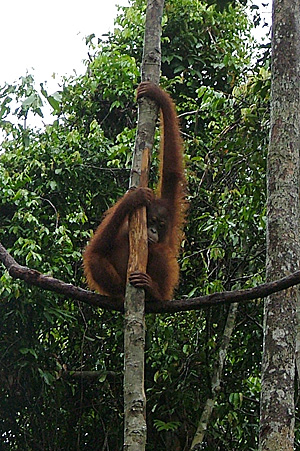 Saut surveying his new freedom. Photo courtesy of Janie Dubman. |
Following released ex-captive orangutans is considered the cushy part of the field assistants’ job (following wild orangutans necessitates getting up before the orangutans—at 4 am, and going home after they’ve nested for the night—at 6 pm). However, for tracking ‘lazy’ human-raised ones, we only need to get up at 5 am. So I got up at 5 am with the rest of the crew (all Indonesian—OFI only employs local people). We ate something non-perishable and fried for breakfast, pulled on delicately moldy jungle gear and went out into the lavender mist of a tropical morning.
Saut was sleeping in a tree less than ten meters from the platform where he was initially released, and had solved his nocturnal jungle jitters in a truly adorable manner: he and Frangki, both either too nervous or tired to make a nest, had clasped each other and slept in a large tree fork 15 meters above the ground. After surviving the night, Saut regained his intrepid courage, and his independent nature re-asserted itself. During the morning, which turned from delightful to dreary, he continued exploring the area in the immediate vicinity of his release site (which required nothing more of us than sitting on a large root and craning our necks to look upwards and take notes). He climbed, tasted leaves, play-fought and just sat. However, once the rain eased off, Saut got his big break: a large sub-adult male swayed the tree Saut was sitting on, allowing our small hero to scramble across to the next stand of trees which was continuous with the rest of the forest, and off he went. This involved us criss-crossing terrain that is a unique jumble of swamp, dead-wood, root systems, lianas, streams and thick leafy dry ground. It really made me value the physical challenge that Dr. Galdikas faced in her early years of wild orangutan follows in the jungle, before trail systems were established. Saut had zero consideration for his ground-bound human observers as he swung and scrambled through the trees. The local kids, past releasees of the station, seemed to accept Saut readily, since he spent all day in the company of juveniles older than himself, tumbling on the ground and chasing each other—underscoring the relative gregariousness of orangutan youngsters, so unlike adults of their kind.
That night, he did not seek out Frangki (who turned out to be a much more cautious type and stayed close to the camp cabin all day); instead, Saut discovered an old but well-made night nest which was lined by a t-shirt evidently stolen from the laundry line. Unfortunately for him, the nest was already occupied for the night by wily Dopung, another juvenile male. At first Dopung exercised his squatter’s rights vigorously and refused Saut entrance to the nest—however, after a persistent hour Saut was allowed in, after which both orangutans promptly fell asleep.
The next morning Saut seemed even keener to really learn about his new surroundings. He spent much more time traveling alone and sampling a variety of wild young leaves (there was very little fruit in the forest that month). His traveling had a purposeful directionality, too, and a faster pace. In fact, even though two experienced forest assistants and myself were following him constantly, we lost sight of him at the end of an open field. This is not unusual during orangutan follows and so we calmly searched for him in the woodland-type habitat. However, after 3 hours of searching and a drenching torrential storm we were not feeling so cheerful. Even less so three hours later, when it got dark and there was no sight or sound of Saut. I was devastated and could barely hide it from the assistants (Indonesians get very upset with personal or social disharmony)—I was worried about Saut’s fate and frustrated at myself for what I felt to be negligence.
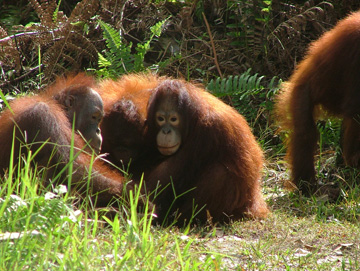 Handsome Saut playing with peers. Photo courtesy of Janie Dubman. |
While searching the next day the kind assistants showered me with stories, accumulated over 40 years of work with OFI and orangutans, of escaped, vanished or MIA orangutans which returned, safe and sound, from lengthy solitary explorations. I was comforted a little but still insisted on trailing wider and wider circles around the release site until we got into territory which no orangutan normally covers in a day. The fact is, of course, that an orangutan which does not wish to be seen has to do nothing more than sit quietly on a branch of a leafy tree while noisy people walk around under him, calling and scanning. I’m now convinced this was the case with Saut, for after I returned from the release station back to the village, I received reports stating that my little stubborn study subject returned to the camp’s vicinity the day after I left.
Reviewing the behavioral and activity data, we felt a high degree of confidence in spunky Saut’s jungle survival and success—but not completely. For such is the nature of the rehabilitation beast (no pun intended): we do our best, try to prevent the worst, and pray, because much like the rapid processes that are creating orphans, our knowledge of how to save them is still growing and evolving.
Related articles
Orangutans can survive in timber plantations, selectively logged forests
(09/23/2010) Selectively logged forests and timber plantations can serve as habitat for orangutans, suggesting that populations of the endangered ape may be more resilient than previously believed, reports research published in the journal PlosONE. The study, conducted by a team of researchers led by Erik Meijaard of Jakarta-based People and Nature Consulting International, found roughly equivalent population densities between natural forest areas and two pulp and paper plantation concessions in East Kalimantan, Indonesian Borneo.
Orangutan populations collapse in pristine forest areas

(08/12/2010) Orangutan encounter rates have fallen six-fold in Borneo over the past 150 years, report researchers writing in the journal PLoS One. Erik Meijaard, an ecologist with People and Nature Consulting International, and colleagues compared present-day encounter rates with collection rates from naturalists working in the mid-19th Century. They found orangutans are much rarer today even in pristine forest areas. The results suggest hunting is taking a toll on orangutan populations.

(07/29/2010) Many of the environmental issues facing Indonesia are embodied in the plight of the orangutan, the red ape that inhabits the islands of Borneo and Sumatra. Orangutan populations have plummeted over the past century, a result of hunting, habitat loss, the pet trade, and human-ape conflict. Accordingly, governments, charities, and concerned individuals have ploughed tens of millions of dollars into orangutan conservation, but have little to show in terms of slowing or reversing the decline. The same can be said about forest conservation in Indonesia: while massive amounts of money have been put toward protecting and sustainable using forests, the sum is dwarfed by the returns from converting forests into timber, rice, paper, and palm oil. So orangutans—and forests—continue to lose out to economic development, at least as conventionally pursued. Poor governance means that even when well-intentioned measures are in place, they are often undermined by corruption, apathy, or poorly-designed policies. So is there a future for Indonesia’s red apes and their forest home? Erik Meijaard, an ecologist who has worked in Indonesia since 1993 and is considered a world authority on orangutan populations, is cautiously optimistic, although he sees no ‘silver bullet’ solutions.
Captive orangutans: enriching bodies, minds, and lives

(07/22/2010) Visitors to the Orangutan Care Center and Quarantine (OCCQ) are always delighted by the sight of playful young orangutans. Hairy orange youngsters swinging through the branches or tossing balls around always induce fits of cooing and camera clicking. These activities appear to be so natural that it is easy to forget these are orphans in rehabilitation school and one of the main classes is Enrichment. The term enrichment has become a catchword in the world of captive animal husbandry in the past few years and for many organizations, enrichment has become a new focus as more and more research reveals how critical enrichment is to the physical, mental, and emotional wellbeing of captive animals.
KFC, Walmart contributing to destruction of Indonesia’s rainforests, endangering orangutans

(07/05/2010) Major U.S. companies are contributing to the destruction of Indonesia’s rainforests by sourcing paper from Asia Pulp and Paper (APP), a subsidiary of Indonesia-based conglomerate Sinar Mas, alleges a new report from Greenpeace. Investigating two sites on the Indonesian island of Sumatra, the activist group documented destruction of rainforests and carbon-dense peatlands by APP, a company that has lost several major contacts in recent years due to its poor environmental record. Greenpeace called out Walmart, Auchan, and Kentucky Fried Chicken (KFC) as companies that continue to buy from APP despite its role in deforestation and peatlands degradation.
Hope for survival as isolated orangutans joined by rope bridge

(04/11/2010) Researchers in the Malaysian state of Sabah in Borneo are joyful after receiving confirmation that a young male orangutan used a rope bridge to cross a river, which has separated one orangutan population from another. Due to logging and clearing forests for oil palm plantations, which cover 18 percent of land in Sabah, orangutans on the Kinabantangan River have been cut into fragmented populations.

(03/01/2010) It is no secret that orangutans are threatened with extinction because their rain forests are being destroyed at an alarming rate. Ten years ago, Shawn Thompson, a writer, former journalist and university professor, set out to chronicle the threat to orangutans in a book released in March 2010. The book is called The Intimate Ape: Orangutans and the Secret Life of a Vanishing Species. The book spends most of the time talking about the nature of orangutans and the relationships between orangutans and people. But the ultimate underlying message is there about the source of the peril to orangutans and the solution. Thompson says that the problem of saving orangutans has to do with communications and human nature.
Humans push half of the world’s primates toward extinction, lemurs in particular trouble
(02/18/2010) Of the known 634 primate species in the world 48 percent are currently threatened with extinction, making mankind’s closes relatives one of the most endangered animal groups in the world. In order to bring awareness to the desperate state of primates, a new report by the International Union for the Conservation of Nature highlights twenty-five primates in the most need of rapid conservation action. Compiled by 85 experts the report, entitled Primates in Peril: The World’s 25 Most Endangered Primates, 2008–2010, includes six primates from Africa, eleven from Asia, three from Central and South America, and five from the island of Madagascar.
Orangutans vs palm oil in Malaysia: setting the record straight

(01/16/2010) The Malaysian palm oil industry has been broadly accused of contributing to the dramatic decline in orangutan populations in Sabah, a state in northern Borneo, over the past 30 years. The industry has staunchly denied these charges and responded with marketing campaigns claiming the opposite: that oil palm plantations can support and nourish the great red apes. The issue came to a head last October at the Orangutan Colloquium held in Kota Kinabalu. There, confronted by orangutan biologists, the palm oil industry pledged to support restoring forest corridors along rivers in order to help facilitate movement of orangutans between remaining forest reserves across seas of oil palm plantations. Attending NGOs agreed that they would need to work with industry to find a balance that would allow the ongoing survival of orangutans in the wild. Nevertheless the conference was still marked by much of the same rhetoric that has characterized most of these meetings — chief palm oil industry officials again made dubious claims about the environmental stewardship of the industry. However this time there was at least acknowledgment that palm oil needs to play an active role in conservation.
